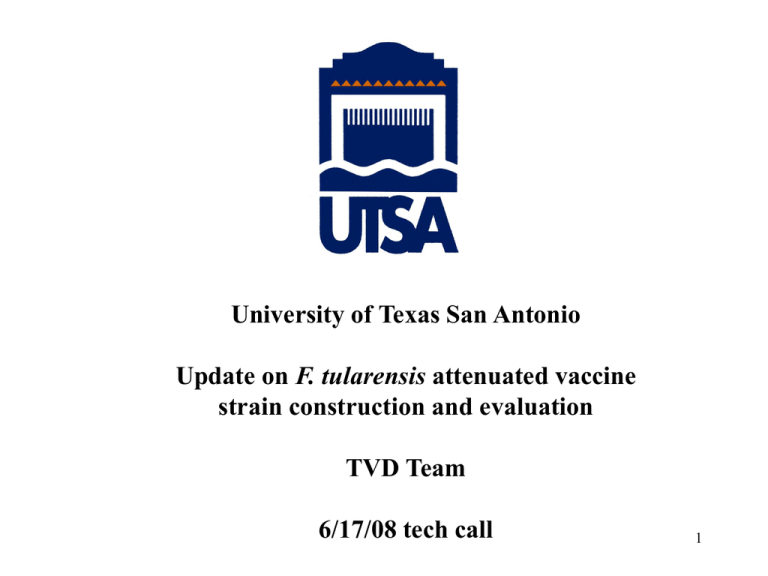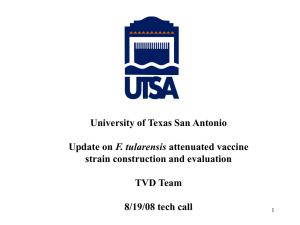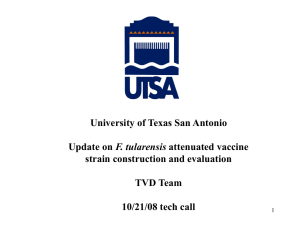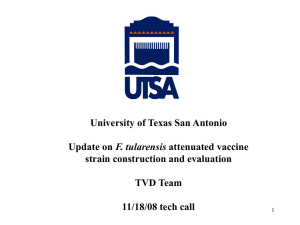University of Texas San Antonio F. tularensis strain construction and evaluation TVD Team
advertisement

University of Texas San Antonio Update on F. tularensis attenuated vaccine strain construction and evaluation TVD Team 6/17/08 tech call 1 Active milestones during last reporting period: Milestone #49B: Construction of iglD, vgrG F. tularensis subsp. tularensis strain Milestone #50: Immunologic characterization of F. tularensis subsp. novicida, subsp. tularensis, and LVS strains Milestone #52: Create recA mutants in F. tularensis subsp. tularensis 2 Red: completed Green: in progress Blue: Steps in the milestone Milestone 49 Creation of mutant F. tularensis subsp. tularensis strains A. Construct iglC mutagenesis plasmid(s) Transform into Schuh4, select for transconjugate, Counterselect for mutant B. Construct vgrG, iglD mutagenesis plasmids Mate into Schuh4, select for transconjugate, Counterselect for mutant Verify mutants, Pass on to Milestone 50 C. Construct iglA, iglB mutagenesis plasmids Mate into Schuh4, select for transconjugate, Counterselect for mutant 3 Milestone #49: Construction of vgrG, iglD F. tularensis subsp. tularensis strain •We are working on creating two different mutant Schuh4 strains: iglD and vgrG •iglD transformants from previous month were promising, looked like only mutated iglD, no wildtype-length gene •Several of these were evaluated by Western blot with anti-IglD antisera: IglD can be detected in wildtype Schuh4, but not in any of the potential mutants, confirming they are defective in both iglD genes. 4 •iglD mutant strains were grown at 37°C to remove targetron plasmid: mutant WT PCR with iglD flanking primers confirmed lack of wildtype iglD gene in the two strains frozen away (vertical arrows), these strains have also lost targetron plasmid. •Thus, we have successfully created Schuh4 iglD1 iglD2 strain, this strain will be evaluated for virulence parameters in the next months. •We are also working on creating vgrG Schuh4 mutant, we have not identified “pure” mutant, and are beginning again with transformation of Schuh4 with vgrG targetron plasmid. 5 (documented in UTSA TVD notebook #1 and #5) Red: completed Green: in progress Blue: Steps in the milestone Milestone 52 Creation of recA mutant F. tularensis subsp. tularensis mutant strains Construct recA mutagenesis plasmid Transform into Schuh4, isolate mutant Verify mutants, Pass on to Milestone 50 Transform into iglC, vgrG, iglD (other) Schuh4 strains, isolate mutants 6 •Last month, we reported the identification of Schuh4 recA mutant in transformed colonies. •Pure recA colony was grown at 37°C to remove targetron plasmid: targetron + recA primers recA primers PCR with internal and external recA mutant primers indicates WT strains are correct, frozen away as KKT11 (vertical arrow), •We thus have successfully created Schuh4 recA strain •The Schuh4 recA strain and the LVS recA strain were evaluated for virulence in mice. 7 LVS recA mutant infected i.p. into mice Route of Inoculation I.P. Mock Inoculation Survival Rate Route of Dose (D30) Chall enge (CFU) 1300 7/7 I.P. I.P. Chall enge Survival Rate Dose D6 D30 (CFU) 700 7/7 7/7 110 0/5 LVS recA highly attenuated i.p., LD50 >103 CFU (LVS LD50 ~10 CFU) Schuh4 recA mutant infected i.n. into mice Inoculum KKT11 Wt Schu S4 Route of Inoculation I.n. I.n. Inoculation Dose (CFU) 105 175 Survival Rate D1 D2 D3 D4 D5 D6 5/5 5/5 5/5 5/5 5/5 0/5 5/5 5/5 4/5 0/5 No evidence of Schuh4 recA attenuation at high i.n. dose; LD50 <105 CFU (Schuh4 LD50 ~10 CFU) We will test virulence of Schuh4 recA mutant infected at lower 8 i.n. dose into mice, in case inoculum was too high to see attenuation •We are also creating a plasmid to express bacterial luciferase in F. tularensis •The luciferase gene cluster luxCDABE from Photorhabdus luminescens is active at 37°C. 7 kb luxCDABE EcoRI fragment from pUTminiTn5kmlux EcoRI digested pKEK843 (Ft plasmid with groEL promoter) These fragments are being ligated, transformants will be evaluated next report. (documented in UTSA TVD notebook #2) 9 Milestone 50-A Immunologic characterization of F. tularensis subsp. novicida, subsp. tularensis, and LVS strains F. novicida uvrA, uvrB Double mutant F. novicida uvrA+pdpD F.novicida uvrB+pdpD iglA, iglB, iglC, iglD In vitro Growth In vivo Bacterial Burden LD50 determination In vitro Growth In vivo Bacterial Burden LD50 determination Red: completed Green: in progress Blue: Steps in the milestone LVS: uvrA, uvrB Schu4: iglC, iglD, pdpD, vgrG, In vitro Growth In vivo Bacterial Burden LD50 determination Further immunological characterization based on initial screen 10 Milestone #50A: Immunologic characterization of F. tularensis subsp. novicida, subsp. tularensis, and LVS strains Results Update Evaluate the protective efficacy of intragastric F. novicida iglB vaccination (prime and one boost) against SCHU S4 intranasal challenge in C57BL mice Mice were given intragastrically a single or a booster dose of iglB (103 CFU) and challenged intranasally with 50 or CFU of SCHU S4 three weeks after the final immunization. Survival was monitored daily. 11 100 Moc k Prime Prime/ Boos t 80 60 40 20 0 0 3 6 9 12 15 18 21 Fig. 1. Protective efficacy of F. novicida ΔiglB immunization against F. tularensis infection. C57BL/6 mice (10 per group) were intragastrically (i.g.) primed or primed and boosted with 103 CFU of ΔiglB and challenged intranasally with F. tularensis SCHU S4 strain (50 CFU) three weeks after the final immunization. Mice were monitored for survival rate. Mice received PBS i.g. were used as mock control. Result: Single i.g. vaccination with ΔiglB did not protect C57BL/6 mice against i.n. SCHU S4 challenge (50 CFU), however, survival rate increased to 40% when mice received a booster dose (Fig. 1). All mock control mice were succumbed to SCHU S4 infection by day 6. 12 Milestone #50A: Immunologic characterization of F. tularensis subsp. novicida, subsp. tularensis, and LVS strains Results Update Evaluate the humoral responses (prime/boost) after intragastric F. novicida iglB vaccination Groups of C57BL mice (female, 4-6 weeks) were primed or primed and boosted with 103 CFU of iglB intragastrically. Sera and fecal pellets were collected at day 21 after immunization and assayed for anti- iglB specific antibody titers. 13 A 4000 B 1.00 Total Ab IgG1 3000 0.80 IgG2a 0.60 2000 0.40 1000 0 0.20 0.00 Prime Prime/ Boos t Prime Prime/ Boos t Prime Prime/ Boos t IgA IgM Results:Mice received single immunization of iglB induced significant amount of serum antibody as shown in Fig. 2A. Further IgG isotyping analyses of the sera indicated i.g. immunization of iglB resulted in producing comparable titers of IgG1 and IgG2a. Intragastric immunization also induced measurable anti- iglB specific secretory IgA in the prepared fecal pellet samples (Fig. 2B.). 14 Milestone 50-B Characterization of protective immunity against pulmonary tularemia via intra-gastric LVS vaccination Duration and limits of protective efficacy Correlates of humoral and cellular immunity Survival 1, 2, 3 months Vaccination/boost strategy Bacterial dissemination Histological analyses CD4+ and CD8+ T cell responses Serum antibody responses Secreted, BAL antibody responses Red: completed Green: in progress Blue: Steps in the milestone Contribution of cell mediated and humoral immunity CD4+, CD8+, B cell depletion vaccination/challenge KO mice vaccination/challenge 15 Milestone #50B: Characterization of protective immunity against pulmonary tularemia via intra-gastric LVS vaccination Results Update Analyze the serum and fecal antibody isotypes of mice intragastrically immunized with LVS at 12 weeks after vaccination Mice were vaccinated intragastrically with 103 CFU LVS or mock immunized with PBS alone. At 12 weeks after inoculation, blood and feces were collected. Some mice received a second booster dose of 103 CFU LVS I.G. Blood and fecal pellets were collected from these mice three weeks after booster vaccination dose. Specific anti-LVS total antibody titers, as well as IgG1, IgG2a, and IgA isotypes for serum and Ig (H+L), IgA and IgM isotypes for fecal samples, were determined by ELISA. 16 20000 LVS 12 wk 10000 LVS 12 wk + Boost Mock (PBS) 50% Binding Titer LVS/ HEL Mock (PBS)/ HEL 1000 100 Total Ab IgG1 IgG2a IgA Fig. 1. Humoral responses to intragastric LVS immunization at 12 week timepoint. Groups of BALB/c mice were vaccinated I.G. with 103 CFU of LVS or PBS as a control. Sera were collected 12 weeks later and analyzed to determine titers for anti-LVS specific antibodies. Some mice were given a second boost dose of LVS I.G. at 12 weeks and sera was collected 3 weeks later. Results: As shown in Fig. 1, mice immunized with LVS I.G. have decreased total antibody titers at 12 weeks when compared to analyses performed at 8 weeks after vaccination. Mice which received a second dose of LVS at 12 weeks after initial vaccination had comparable titers. 17 LVS 12 wk LVS 12 wk + Boos t Moc k (PBS) LVS/HEL M oc k (PBS)/HEL O.D. (630 nm) 0.80 Ig (H+L) 2.00 IgA 0.20 0.60 1.50 0.15 0.40 1.00 0.10 0.20 0.50 0.05 0.00 0.00 0.00 IgM Fig. 2. Humoral responses to intragastric LVS immunization at 12 week timepoint. Groups of BALB/c mice were vaccinated I.G. with 103 CFU of LVS or PBS as a control. Fecal samples were collected 3 weeks later and analyzed to determine titers for anti-LVS specific antibodies. Some mice were given a second boost dose of LVS I.G. at 12 weeks and fecal samples were collected 3 weeks later. Results: As shown in Fig. 2, mice retain high levels LVS-specific IgA in the G.I. tract at 12 weeks after vaccination. There was comparable levels of IgA in the boosted mice. Similar to the 3 and 8 week time points, there were minimal amounts of LVS-specific total antibody and almost no IgM isotype. 18 Milestone #50B: Characterization of protective immunity against pulmonary tularemia via intra-gastric LVS vaccination Results Update Perform histological analyses on tissues at varying time points after LVS intragastric immunization and subsequent SCHU S4 challenge BALB/c mice were vaccinated intragastrically with 103 CFU LVS or mock immunized with PBS alone. Four weeks later, mice were challenged intranasally with 100 CFU SCHU S4. At various time points after challenge (3, 15 and 30 days), mice were sacrificed and lungs were collected. Briefly, 10% neutral buffered formalin was injected in to the lungs via the trachea wherein lungs were removed and set overnight in formalin for fixation. Tissues were then imbedded in paraffin and sliced in 5 mm sections and placed on slides, 3 sections per slide. Every fourth slide was stained with hematoxylin 19 and eosin and visualized using light microscopy. Results: As shown in Fig. 3, at three days post-infection, mock immunized lungs displayed minimal inflammatory cellular infiltration. In contrast, lungs from LVS vaccinated mice displayed focal peri-bronchiolar and peri-vascular mononuclear cell infiltration, which appear to be predominantly composed of lymphocytes. At 15 days after challenge, lungs from vaccinated mice showed a greater degree of peri-bronchiolar and peri-vascular lymphocytic infiltration, including the presence of bronchiolar and 20 vascular cuffing by the inflammatory cells. At 30 days after challenge, lung sections from vaccinated mice displayed minimal inflammatory cellular infiltrates. Mock vaccinated mice succumb to infection by day 5 after challenge. Plan for following month: Milestone #16: completed. Milestone #39: completed. Milestone #48: completed. Milestone #43: completed. Milestone #51: completed. Milestone #49: 1. Evaluate iglD1 iglD2 Schuh4 mutant for virulence. 2. Isolate pure vgrG1 vgrG2 Schuh4 mutant. 3. Continue working on pdpD::FRT plasmid. Milestone #52: 1. Test Schuh4 recA mutant for virulence at lower inoculum 2. Work on cloning luxCDABE into Ft expression plasmid. Continued on following slide 21 Plan for following month: Milestone #50-A&B: 50A:. (1) Measure intramacrophage (J774) replication of Ft subsp. tularensis (SCHU S4) iglD mutant 50B: (1) Survival after LVS I.G. vaccination and SHU S4 challenge at 8 weeks after immunization . (2) Histological analyses of lungs of LVS vaccinated mice at 45 and 60 days after challenge to check for the presence of long-term pathology. 22 Action Items • Rick/Terry: will share with Bernard, the results of the comparative i.n. LVS vaccination results with mice from different vendors 23



